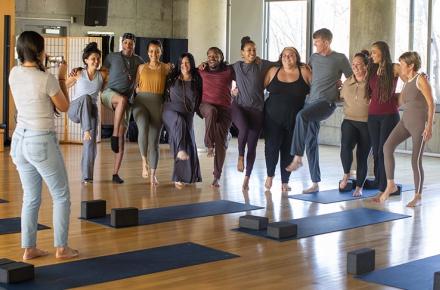The Secret to Creating a Resilient Life
One of the common myths about resilience is that some people are simply born with it, while the rest of us aren’t. The good news is that anyone can build the skills necessary to cope and even thrive in difficult times. The first step is recognizing that resilience is a choice,” explains Kripalu faculty member Maria Sirois. She says that one common mistake people make when a crisis hits, or when they’re dealing with a stressful situation, like a breakup or losing a job, is to think, “This is how it is, this is how it’s going to be, and it’s never going to get better.” That's just not true. Here are Maria's guidelines for taking steps toward creating a more resilient life.
Learn to pause. The first thing to learn is how to take a moment when you’re triggered. That means being aware of what’s pushing your buttons, and taking a breath or a walk before reacting. Maria, who teaches Crafting the Resilient Life at Kripalu, says we often make the situation worse by going into rage, terror, fear, worry, or depression. If you can recognize that your thoughts and feelings have converged in a negative place, it’s helpful. It’s important to allow yourself to feel sad, lonely, or scared—but resilient people don’t stop there. They reach out for help.
The skillful next step is to contact a good friend, an expert, or a life coach. Leaning on the right people—not someone who is going to make you feel worse—is one of the healthiest ways to move forward, Maria says.
Learn your signature strengths. Resilient people lean into difficult moments from their strengths. Not sure of your strengths? Researcher Martin Seligman, known as “the father of Positive Psychology,” and his team created a survey that can help you pinpoint what they are. Some examples include humor, perseverance, zest, gratitude, forgiveness, leadership, and hope.
Here’s an example of how your strengths can inform your life choices: Imagine that you’re in a job you don’t love, but you can’t quit because you need the money and don’t have a Plan B. So every day is challenging.
“Given that this is the reality, resilient people will ask themselves, ‘How can I can be larger than this chronic, irritating stressor?,’” says Maria. Then they will look at their list of character strengths and see, for example, that humor is in their top 10. So how can they use humor every day to create more positivity? That might mean joking around more at the office or not taking the job so seriously. Or, if zest is on the list, they might find creative ways to bring enthusiasm into their days.
Learn how daily practice leads to breakthroughs. If you practice using your strengths to navigate your day, you eventually learn this crucial point: You can shape each day as an opportunity for growth. Think of each day as an experiment in which you can choose to experience happiness or misery, in which you can become your best self and make the most of it.
Learn to find the benefits. Resilient people look for the upside of a situation, even during the darkest times. Nelson Mandela famously said that his 27 years in prison afforded him two great benefits: He had time to read and time to think.
In other words, as Ralph Waldo Emerson wrote, “The same world, to different minds, is a hell and a heaven.” That quote, Maria says, sums up how it’s not about your job, or your relationship, or your health, or how much money you have.
The circumstances don’t matter that much. The secret to a happy, resilient life is your perspective.
© Kripalu Center for Yoga & Health. All rights reserved. To request permission to reprint, please e-mail editor@kripalu.org.





























